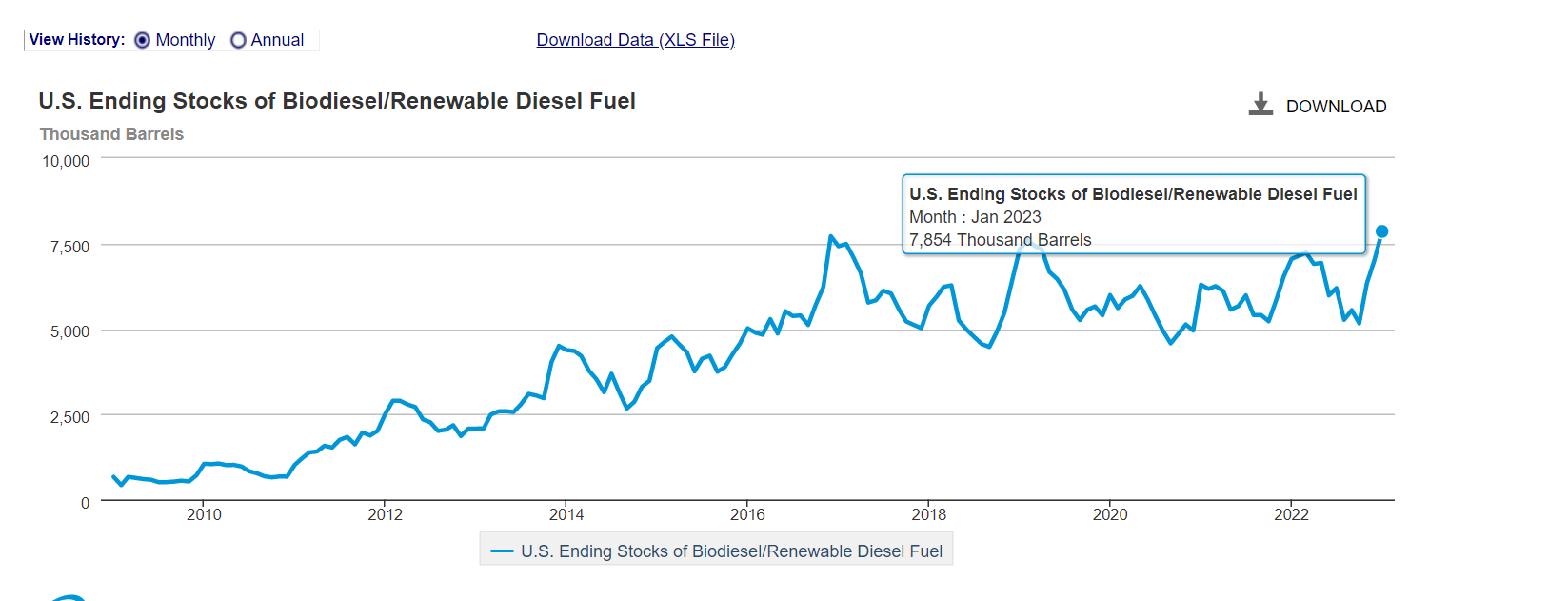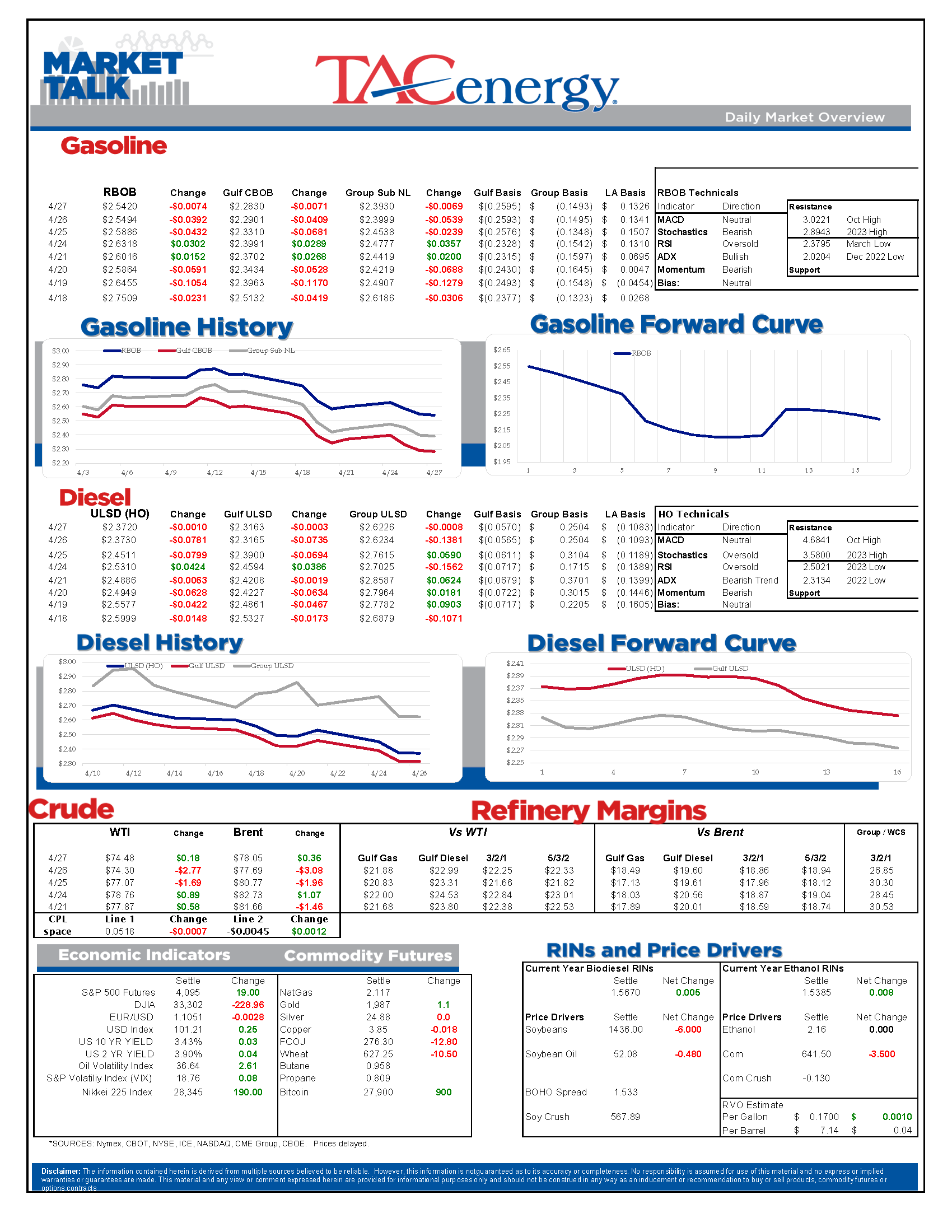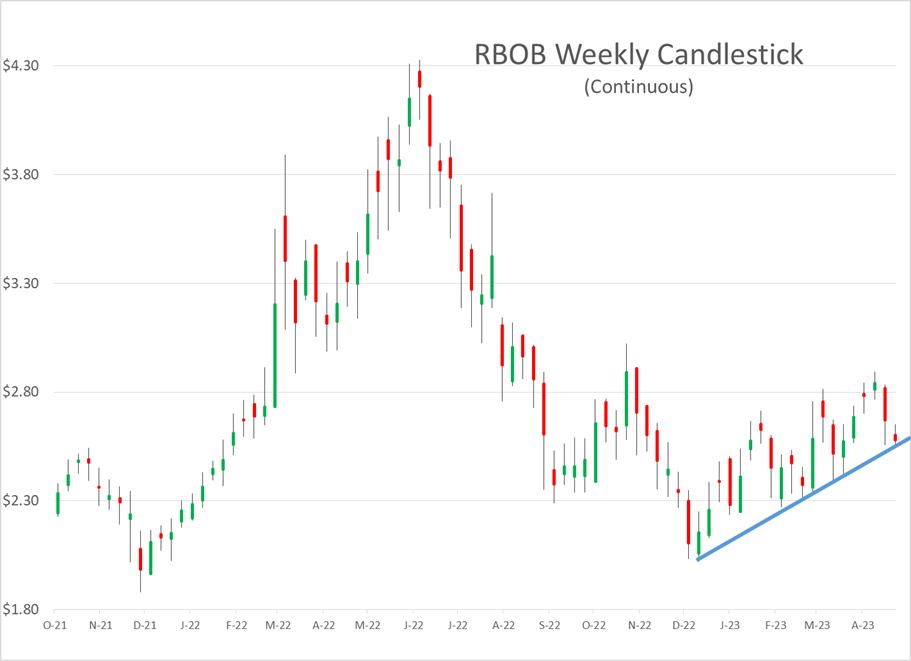April Energy Futures Struggle To Finish Strong, Diesel Demand Remains Soft

Energy futures are stumbling to the finish line with just 2 days left in April trading and most contracts hovering around their lowest levels of the month.
US Oil inventories fell for a 4th week out of 5, despite more barrels being taken out of the SPR, and the EIA finding another 8 million barrels of oil in their adjustment figure last week. Refinery runs and oil exports remain strong, and the oil production estimate dipped last week, which all contributed to that draw in stocks.
RBOB futures did see a healthy rebound off of their lows Wednesday after the EIA reported a strong demand estimate that helped pull inventories lower last week. That recovery bounce was short lived however and RBOB prices find themselves teetering on the edge of their weekly trend line once again this morning, and poised to drop below it once the June contract takes the prompt position next week, unless we get a nickel or more bounce in the last two days of trading for the month.
Diesel demand estimates continue to be very soft, consistent with the steady drumbeat of “freight recession” warnings that have been issued in recent weeks. While refiners are likely to report record earnings for a first quarter this week, that soft outlook for diesel, and the recent collapse in crack spreads that’s come with it, have created a much different outlook for the balance of the year.
ULSD prices have dropped to their lowest level since the first day of trading in 2022, with several spot markets reaching their lowest levels since December of 2021, despite the fact that diesel inventories remain at the bottom end of their seasonal range across all 5 PADDs included in the report. The PADD 5 figure is the most misleading however as the EIA figures are not yet capturing the rapid influx of renewable diesel into these figures, so actual commercial diesel inventories will be higher than the official figures.
The EIA’s latest report on Biodiesel and Renewable diesel inventories showed a record high of 7.8 million barrels of combined inventory in the US as of January, but it does not break out biodiesel and RD stocks. It seems inevitable that the EIA will eventually include RD inventories in their weekly figures as they do with ethanol, particularly now that RD is moving along major pipeline systems in California, but that could still be years away given the glacial speed in which government agencies tend to move.
Speaking of which, you may note that PADD 3 refinery utilization rates look abnormally high. You’d be correct in that assessment since the EIA’s data continues to report the actual output generated by Exxon’s new 250mb/day expansion in Beaumont but won’t report that as actual refining capacity which is artificially inflating the percentage utilization.
Side note, did you know there are actually 7 PADDs but the EIA doesn’t include 6 and 7 in its weekly reports? Also, did you know that a US congressperson once worried that one of PADD 7s islands might tip over and capsize? Can’t make that stuff up.
News & Views
View All
Energy Futures Are Caught Up In Headline Tug-O-War This Morning
Energy futures are caught up in headline tug-o-war this morning with Canadian oil production concerns and a positive US GDP report trying to push prices higher while sinking Chinese demand worries and Gaza ceasefire hopes are applying downward pressure. The latter two seem to be favored more so far this morning with WTI and Brent crude oil futures down ~45 cents per barrel, while gasoline and diesel prices are down about half a cent and two cents, respectively.
No news is good news? Chicago gasoline prices dropped nearly 30 cents yesterday, despite there not being any update on Exxon’s Joliet refinery after further damage was discovered Wednesday. Its tough to say if traders have realized the supply situation isn’t as bad as originally thought or if this historically volatile market is just being itself (aka ‘Chicago being Chicago’).
The rain isn’t letting up along the Texas Gulf Coast today and is forecasted to carry on through the weekend. While much of the greater Houston area is under flood watch, only two refineries are within the (more serious) flood warning area: Marathon’s Galveston Bay and Valero’s Texas City refineries. However, notification that more work is needed at Phillip’s 66 Borger refinery (up in the panhandle) is the only filing we’ve seen come through the TECQ, so far.
Premiums over the tariff on Colonial’s Line 1 (aka linespace value) returned to zero yesterday, and actually traded in the negatives, after its extended run of positive values atypical of this time of year. Line 1’s counterpart, Line 2, which carries distillates from Houston to Greensboro NC, has traded at a discount so far this year, due to the healthy, if not over-, supply of diesel along the eastern seaboard.
Click here to download a PDF of today's TACenergy Market Talk.

WTI And Brent Crude Oil Futures Are Trading ~$1.50 Per Barrel Lower In Pre-Market Trading
The across-the-board drawdown in national energy stockpiles, as reported by the Department of Energy yesterday, stoked bullish sentiment Wednesday and prompt month gasoline, diesel, and crude oil futures published gains on the day. Those gains are being given back this morning.
The surprise rate cut by the People’s Bank of China is being blamed for the selling we are seeing in energy markets this morning. While the interest rate drop in both short- and medium-term loans won’t likely affect energy prices outright, the concern lies in the overall economic health of the world’s second largest economy and crude oil consumer. Prompt month WTI and Brent crude oil futures are trading ~$1.50 per barrel lower in pre-market trading, gasoline and diesel are following suit, shaving off .0400-.0450 per gallon.
Chicagoland RBOB has maintained its 60-cent premium over New York prices through this morning and shows no sign of coming down any time soon. Quite the opposite in fact: the storm damage, which knocked Exxon Mobil’s Joliet refinery offline on 7/15, seems to be more extensive than initially thought, potentially extending the repair time and pushing back the expected return date.
There are three main refineries that feed the Chicago market, the impact from one of them shutting down abruptly can be seen in the charts derived from aforementioned data published by the DOE. Refinery throughput in PADD 2 dropped 183,000 barrels per day, driving gasoline stockpiles in the area down to a new 5-year seasonal low.
While it seems all is quiet on the Atlantic front (for now), America’s Refineryland is forecasted to receive non-stop rain and thunderstorms for the next four days. While it may not be as dramatic as a hurricane, flooding and power outages can shut down refineries, and cities for that matter, all the same, as we learned from Beryl.



